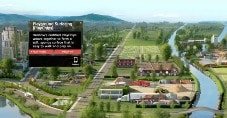9 Benefits to Using Compost for Erosion and Sediment Control
/0 Comments/in Environment, Erosion Control, Municipal and Infrastructure Journal, Sediment Control, Slope Stabilization, Stormwater Management, Sustainable Development /by Tanya RichardsVIDEO: EcoBlanket installation in Abbotsford
/0 Comments/in Erosion Control, Projects, Slope Stabilization /by Tanya Richards5 Steps for Erosion Control on Steep Slopes and Embankments
/34 Comments/in Erosion Control, Green Infrastructure, Slope Stabilization /by Tanya RichardsFor the most part, soil will stay put. However, on steep slopes and embankments, there is the elevated risk of erosion. It is essential to put as much effort as possible into actions that will stop the soil from washing away. This is because not only could this make the area that has been eroded barren, but it could also adversely affect water supply and introduce pollutants. Additionally, it could take decades to rebuild even the initial layer of topsoil, so it essential to have some insight on how to keep topsoil in place.
There are many methods that could be used to help prevent or stop erosion on steep slopes, some of which are listed below.
Plant Grass and Shrubs
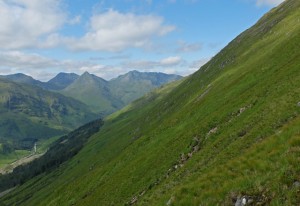 Grass and shrubs are very effective at stopping soil erosion. This is primarily because plant roots tend to hold soil together, making it harder to erode. The leaves of the plants also help to reduce the velocity of raindrops falling on the ground, making it harder for them to dislodge the soil and erode it. Ornamental grass and low, spreading shrubs work best as they leave no areas of bare soil exposed to the elements.
Grass and shrubs are very effective at stopping soil erosion. This is primarily because plant roots tend to hold soil together, making it harder to erode. The leaves of the plants also help to reduce the velocity of raindrops falling on the ground, making it harder for them to dislodge the soil and erode it. Ornamental grass and low, spreading shrubs work best as they leave no areas of bare soil exposed to the elements.
Use Erosion Control Blankets to Add Vegetation to Slopes
There are many varieties of fiber, biodegradable, and compost blankets/mats on the market today, and they have all been designed with one aim; to minimize the effects of water erosion on slopes and embankments. Rolled mats are usually made from mulch that is held together by a fiber mesh. They degrade slowly, allowing vegetation that may have been grown in the area to grow and take over the job of protecting the soil from erosion when the mats have finally degraded completely. Compost erosion control blankets act similarly to mulch products but provide organic nutrients that promote vegetation growth, even in areas where germination, moisture management and irrigation could be challenging.
Build Terraces
 If you are planning on trying to control the erosion on very steep slopes or embankments, sometimes planting vegetation may just not cut it as the slope may be too steep to support anything other than the hardiest grass due to the rapid rate of erosion. If this is the case, you should consider building terraces to help slow down erosion as the vegetation takes hold. Terraces can be made out of anything, from wood to concrete blocks to bio-mechanical solutions like the Cascadia Green Wall that uses Filter Soxx with natural mulch/seed filling and geogrid for structural stability. The beds that are created by the terraces can then be used to plant vegetation such as ornamental plants or grass.
If you are planning on trying to control the erosion on very steep slopes or embankments, sometimes planting vegetation may just not cut it as the slope may be too steep to support anything other than the hardiest grass due to the rapid rate of erosion. If this is the case, you should consider building terraces to help slow down erosion as the vegetation takes hold. Terraces can be made out of anything, from wood to concrete blocks to bio-mechanical solutions like the Cascadia Green Wall that uses Filter Soxx with natural mulch/seed filling and geogrid for structural stability. The beds that are created by the terraces can then be used to plant vegetation such as ornamental plants or grass.
Create Diversions to Help Drainage
Depending on the incline of the slope or embankment, one of the most effective ways to help prevent erosion is to create diversions which will channel excess water down the slope along a predetermined path. One of the simplest ways to do this is to create open ditches or drains by simply digging along the slope at regular intervals. Use of pipes and gutters is also very effective, and work just as well as natural drains when designed and installed properly.
EcoBlanket on slopes at Albion
/0 Comments/in Construction Landscape Journal, Environment, Erosion Control, Slope Stabilization, Sustainable Development /by Tanya RichardsErosion Control on Steep Slopes and Embankments
/6 Comments/in Environment, Erosion Control, Municipal and Infrastructure Journal, Sediment Control, Streambank Restoration, Water Abatement /by Tanya RichardsErosion Control
As land development happens in hilly countryside, more erosion control on steep slopes and embankments is needed. Especially in areas that experience heavy rainfall. Steep slopes and embankments that have no vegetation or cover are especially vulnerable to erosion issues. Erosion can cause damage to not only the landscape, but any infrastructure surrounding the project. It is important to protect the hillside from erosion during and after the project is complete.
Erosion is basically the displacement of soil from one area to another. On steep slopes and embankments erosion is caused primarily by water, especially by heavy rainfall. Rain that falls onto the exposed ground dislodges soil particles which are then carried away down the slope by the flowing water. However, it is the resulting destabilization of slope that creates an even greater danger as rocks and trees roots become exposed.
There are several ways of controlling erosion on steep slopes and embankments.
 Natural Solutions
Natural Solutions
The most effective, natural way to control soil erosion on steep slopes and embankments is to plant vegetation. Not only will the grass, fescue and leaves help to slow down raindrops as they fall, the roots of the plants will also help to hold the soil together, making it harder for water to wash it away.
However, when planting vegetation on a slope to stop erosion, you need to keep in mind that what you’re planting is just as important as the planting. Though grasses can create a groundcover that can absorb some moisture, they have less effective storm water filtration ability compared to native ground cover. Various typical erosion control seed specifications are available as well as custom seed blends to mimic the native grasses in the area.
Artificial Solutions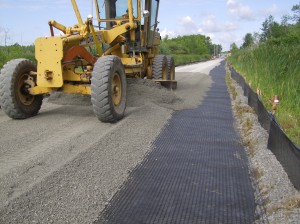
Other than planting vegetation, there are also a variety of artificial solutions you can use. For instance, the use of geomats has become popular over the last few years. Geomats are water permeable polymers that are used to help fix soil elements, grass and small plant roots, and have been shown to work extremely well, especially on barren slopes that have no vegetation. There are even biodegradable geomats that are now being produced that are designed to prevent erosion and give freshly planted vegetation a chance to grow.
Building Terraces
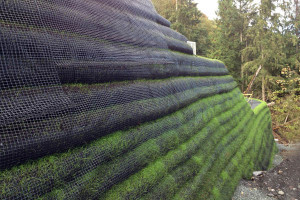 Building terraces is also another way to help prevent soil erosion. When most people think of terraces as a method of erosion control, some may think of the incas in Peru. There the natives implemented the early methods of erosion control on the Andes mountains for many centuries. Terrace walls help to hold soil in place while providing a convenient surface to plant a variety of plants. Building terraces can be as simple as using a couple of wooden blocks to create a terrace wall, or it could be more sophisticated and involve the use of engineered stones, concrete retaining wall blocks or a living green wall solution.
Building terraces is also another way to help prevent soil erosion. When most people think of terraces as a method of erosion control, some may think of the incas in Peru. There the natives implemented the early methods of erosion control on the Andes mountains for many centuries. Terrace walls help to hold soil in place while providing a convenient surface to plant a variety of plants. Building terraces can be as simple as using a couple of wooden blocks to create a terrace wall, or it could be more sophisticated and involve the use of engineered stones, concrete retaining wall blocks or a living green wall solution.
Soil Composition Enhancement
You could also control erosion by controlling the soil itself. As heavy rain tends to be the biggest culprit for soil erosion on slopes and embankments, by controlling the composition of the soil, you 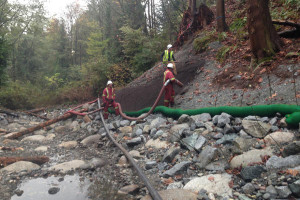 could control the effect that water has on it and therefore the likelihood that it will be eroded. Soil that is high in organic material tends to absorb more water, therefore, using organic material such as compost, aged mulch, or a manure can go a long way in preventing soil erosion.
could control the effect that water has on it and therefore the likelihood that it will be eroded. Soil that is high in organic material tends to absorb more water, therefore, using organic material such as compost, aged mulch, or a manure can go a long way in preventing soil erosion.
The best solution (or multiple solutions) is best determined by evaluating each slope individually.
Save
Best Erosion Control Practices
/6 Comments/in Environment, Erosion Control, Stormwater Management, Water Abatement /by Tanya RichardsBest Erosion Control Practices
With any kind of construction, you are bound to face challenges with controlling erosion and the deposit of sediments. The possibility of erosion is elevated by changes being made to the environment of the site. Water runoff contributes to the deposit of sediments and increased pollutants. These negative environmental impacts can all be kept at bay if a few Best Management Practices are implemented at the right time. We’ve outlined these best erosion control practices below for your reference.
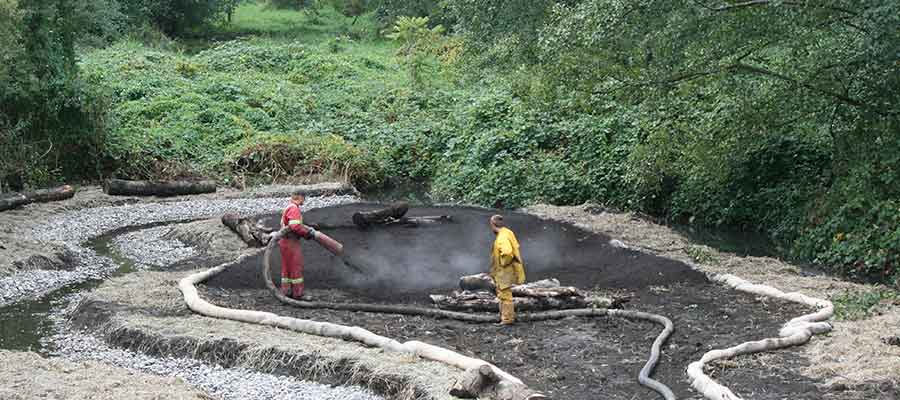
Consider Unique Site Attributes
First you must carefully assess the site that you are working on, as every site is unique. Everything from the intensity, duration, and frequency of rainfall needs to be considered, as does the local geography and landscape. Sites that are on a slope or an incline will be more prone to erosion. The type of soil that the site is on must also be assessed. If the site is on soil that is very easy to erode, more drastic steps may have to be taken to reduce or stop erosion.
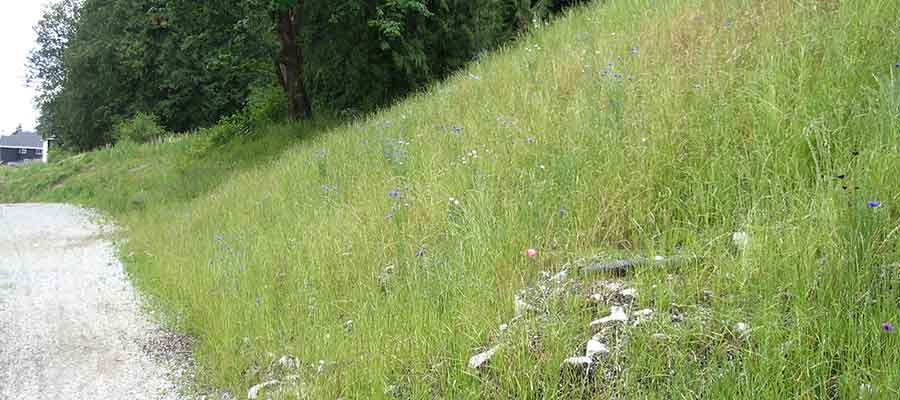
Develop a Project Plan
Once the site has been assessed, you can develop your erosion control plan. Taking care especially when it comes to the order in which different tasks are carried out. For instance, if you are carrying out construction over a wide area, you can begin excavating areas of the site in sections. Systematically move through different areas using a predetermined route, rather than disturbing the whole site. This will help reduce the amount of land that is left exposed for long periods, thereby decreasing erosion.

Managing Water Flow
Controlling water on your site will also be very important. The construction of dikes and ditches to control the flow of water is prudent, especially when they are constructed at the top and bottom of slopes and embankments. Constructing temporary slope drains will also help in mitigating the effects of erosion, especially when these are constructed in cut/fill transitions and steep slopes around the site.
Sediment that runs off a construction site can cause damage to the environment if it ends up in the wrong place, especially if it ends up in water ways surrounding the site. This could upset the ecosystem. Constructing silt fences and sediment traps will go a long way to preventing potential damage to the environment during to construction. Sediment controls should be constructed around the perimeter of the site, at the entrances and exits to the site, and at water inlets and outlets.
Managing Water Pollution
Reducing water pollution caused by erosion and sediment should be a high priority on site. This involves ensuring that a construction site near a water way has the proper erosion and sediment controls in place. If there is to be excavation then it is important to prevent erosion and sediment loss. Prior to the beginning of construction you can put filter sock in place around the edge of the water way. This will protect the water from any heavy sediment run off throughout construction.
Stabilization of soil, on site, after construction may also be necessary. One of the best ways to ensure that you maintain good soil stability is by protecting the existing vegetation that is on the site, including trees, shrubs and forbs. Areas where there is no longer any vegetation can be treated with a seeded compost erosion control blanket – controlling erosion and re-vegetating the area in one step.
Conclusion
In order to best address erosion and sediment controls, it is necessary to first, asses your site. Second, you must develop a project plan. Finally, implement your plan by managing water flow, using engineered structures and protecting the natural vegetation, thus reducing water pollution.
Overwhelming? We recommend partnering with an Environmental Consultant who is familiar with the Erosion and Sediment Control bylaws in the municipality where the project is located. eg: City of Surrey bylaws
We hope you find this article helpful. Please share!
Save
Stone Creek project in Prince George
/0 Comments/in Construction Landscape Journal, Erosion Control, Municipal and Infrastructure Journal, Projects, Slope Stabilization /by Tanya RichardsErosion Control – Ineffective Methods and What Actually Works
/8 Comments/in Erosion Control, Municipal and Infrastructure Journal, Sediment Control, Slope Stabilization, Sustainable Development /by Tanya RichardsNew construction creates conditions that have the potential to cause slope destabilization, dangers to wildlife and fisheries habitats; stormwater runoff increases and results in increased sedimentation. Careful erosion control planning is required to ensure environmental stewardship and safety for generations to come.
In defining an effective approach to erosion control, one should take into consideration both the long-term effectiveness as well as financial feasibility.
The following approaches and methods of erosion control have proved to be ineffective for various reasons:
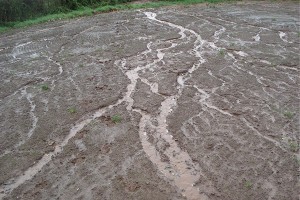 Inadequate site assessment. Though not an end solution, the site assessment is critical when determining which method is used. When important aspects of the site conditions are not taken into consideration, inappropriate “solutions” may be prescribed.
Inadequate site assessment. Though not an end solution, the site assessment is critical when determining which method is used. When important aspects of the site conditions are not taken into consideration, inappropriate “solutions” may be prescribed.
One example of a site condition is the steepness of the slope. The erosive forces of runoff increases with both slope gradient and distance down slope and therefore erosion is typically at it’s maximum at the lowest part of the steepest slope section. Not recognizing or taking into account the destructive force of water during seasonal runoff in scenarios with significant slope and distance will result in ongoing and increasing site erosion.
- A focus on sediment control (managing sediment that has already eroded) instead of focusing on the root of the erosion problem through prevention.Though silt fences and other sediment barriers may be effective in keeping stormwater and fisheries habitats from undue sedimentation, the approach should only be used temporarily. Filter socks like Denbow’s Filtersoxx can be used both as a temporary sediment barriers but also as part of a more comprehensive deployment of erosion control products. Single application solutions, not comprehensive. These methods may provide partial or temporary results but are often not effective for the following reasons:
- Engineered structures – Though usually immediately effective, engineered structures like block retaining walls, do not adapt to changing site conditions, can become progressively weaker over time and are often the most expensive solution. For this reason engineered structures are not always the best method of erosion control.
- Adding rip rap to ditches to minimize/slow runoff. In some scenarios with minimal run-off, rip rap can be effective but in instances with significant water speed and sedimentation, erosion control is not mitigated.
- Adding vegetation alone, without a structural component. Though grasses can create a groundcover that can absorb some moisture, they have no slope stabilization benefits have less effective storm water filtration ability compared to native ground cover.
Erosion Control Solutions that Work
 The solution to these incomplete and ineffective methods is to combine them into a comprehensive bio-structural approach. This approach includes engineered structural components that are paired with natural, vegetative products that will adapt and grow within the site structure over time. Starting with expert consultation to identify the appropriate method, the following are a few combination solutions available for different applications.
The solution to these incomplete and ineffective methods is to combine them into a comprehensive bio-structural approach. This approach includes engineered structural components that are paired with natural, vegetative products that will adapt and grow within the site structure over time. Starting with expert consultation to identify the appropriate method, the following are a few combination solutions available for different applications.
- Similar to hydroseeding, but providing much more of the underlying structure needed to prevent erosion, Terraseeding uses compost-based soils and growing mediums. During the Terraseeding process, seed is injected directly into the soil compost mixture as the material is blown into place, providing optimum moisture and nutrient availability.
- Denbow’s Kicking Horse Canyon Park Bridge project in Golden is an perfect example of combination solutions that utilized Terraseeded EcoBlanket and Filtrexx Rip-rap Grout installed to address erosion and to vegetate extremely steep slopes.
EcoBlanket – On areas with a slope of 50% or less, EcoBlanket is uniformly applied directly at the soil surface with a pneumatic blower as specified by Rexius. Typically applied at a depth of 1 to 2 inches, but application depth can vary depending the site requirements. In extreme conditions and where specified by the Engineer, EcoBerms or FilterSoxx may be added and constructed at the top of the slope and in parallel intervals down the profile of the slope if necessary.
- Extreme slope erosion may require a natural retaining wall solution for reinforcing slopes like Cascadia Green Wall, which allows for natural buffer zone design and water gardens. It is a cost effective solution when compared to concrete, block, gabion retaining walls.
Contact Denbow for an erosion control solution that stands the test of time.
Save
Save
Erosion Control vs. Sediment Control
/0 Comments/in Construction Landscape Journal, Environment, Erosion Control, Municipal and Infrastructure Journal, Sediment Control, Sustainable Development /by Tanya RichardsThe overarching principle of Erosion Control vs. Sediment Control is that it is much easier and cheaper to prevent erosion from occurring in the first place than to try and remove the sediment once it has eroded.
Erosion and Sediment Control is a rapidly changing field. Traditional approaches have been applied with varying levels of success over the years. In addition, there are a host of new approaches, practices, and proprietary products that should be shared, understood, and considered on construction and municipal sites. Sites can be sustainably managed by minimizing the impact of earthwork using proven erosion and sediment control measures..
Erosion Controls are source controls designed to prevent erosion from occurring. Solutions include seeding solutions like hydroseeding and terraseeding, wood chip mulch and rolled erosion control products.
Sediment Controls are downstream controls designed to remove sediment from runoff. Solutions include sediment fences and barriers, filter socks and other forms of mechanical filtration.
At the detailed design stage impacts can be minimized through efficient earthworks and erosion and sediment control measures. It is vital that development be successfully completed in balance with the natural environment.
The Erosion and Sediment Control Association of British Columbia is a non-profit organization is dedicated to increase the level of expertise in the Erosion & Sediment Control field throughout British Columbia. Their list of Best Management Practices are divided into Erosion Control and Sediment Control solutions that we think you will find useful.


